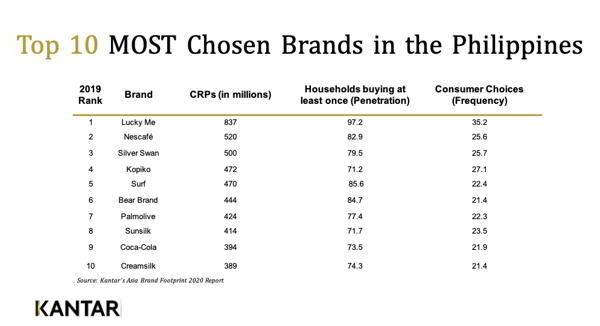Kantar, through its Worldpanel Division in the Philippines, reveals that local noodle brand, Lucky Me, remains as the top most chosen brand in the Philippines for the fifth consecutive year. This data is based on Kantar’s 2020 Asia Brand Footprint report, which ranks Fast Moving Consumer Goods (FMCGs) in eight (8) Asian markets, namely Philippines, China, Indonesia, Korea, Malaysia, Taiwan, Thailand, and Vietnam.
The Asia Brand Footprint rankings reveal how consumers in the region are purchasing FMCG brands. The report also highlights the opportunities that can help these brands increase their footprint in their respective markets. The brands’ rankings were based on Consumer Reach Points (CRP), a unique Kantar measure that combines the number of households purchasing the brand as well as the frequency of it being purchased by consumers.
In the Philippines, the same staple household brands continue to dominate the Top 10 most chosen brands in the country.

Local noodle brand, Lucky Me, continues to dominate the market with 837 million CRP. According to Kantar, the brand was bought by nearly all Philippine households (97.2%) in 2019, more than 35 times a year.
Nescafé (coffee) was also able to retain its foothold as the 2nd most chosen brand in the country reaching over 82% of households. Meanwhile, condiment brand Silver Swan and Kopiko (coffee) ascended one slot to 3rd and 4th place, respectively. Surf continues to be the only detergent brand in the top 10, at number 5 with 470 million purchases.
Coca-Cola reformulated and executed an effective stock keeping unit (SKU) strategy which aided the brand further expand in the market, said Kantar. As a result, it secured the 9th spot in this year’s report, a significant leap from its previous 17th spot on the list.
Although six out of ten brands are from the food and beverage sectors, brands from the beauty and personal care sector were able to retain their slots in the Top 10. Palmolive, Sunsilk, and Creamsilk are still the Filipinos’ most chosen brands when it comes to hair care.
“These brands sustain their leadership position by constantly adapting their portfolio to new consumer needs and conveying this through inspiring communications. Price, however, remains an important factor for Filipino shoppers and several of the fastest growing brands have used this lever to gain more shoppers,” explained Marie-Anne Lezoraine, General Manager, Worldpanel Division, Kantar Philippines.
Growing Brands in the Philippines
Leading the pack of the Top Growing Brands in the Philippines with 54% CRP growth, dairy brand Birch Tree was able to reach four million homes in just 2 years. In a market dominated by bigger packs, the brand’s 33g sachet addressed the Filipinos’ need for a nutritious yet affordable milk alternative. The brand was able to make its products accessible to middle and lower socio-economic classes, who form the majority of Family Milk shoppers, by focusing its sales efforts in sari-sari stores.
Meanwhile, Wings, a local laundry detergent, is the second fastest growing brand in the country with 35% CRP growth. Wings went against traditional launch strategies and introduced its products first in Mindanao, followed by the Visayas region. This proved to be a good strategy, as more than 40% of Filipino homes purchase Wings in Visayas, and almost 70% of homes from Mindanao choose Wings as their laundry detergent.
Bioderm (personal care), Coca-Cola (beverage), Calla (detergent), Gardenia (bread), Pride (detergent), EQ (diaper), Happy (oral care) and Royal Tru Orange (beverage) complete the list of the top brands that demonstrated the highest growth. These brands were able to recruit more shoppers and encourage more frequent purchase in the past year.
Brands during the COVID-19 pandemic
This year, Kantar’s annual ranking includes a special analysis of how brands have navigated the COVID-19 pandemic, particularly on showing signs of growth during such uncertainty.
The Kantar report notes that categories like hygiene, cooking and baking essentials products are thriving. Across these categories, the biggest brands across Asia are winning by riding on one or more of the five key levers for brand growth. These five levers include: the ability to recognize new consumer needs, create more shopping opportunities by making products relevant to consumers, ability to stretch across different categories to attract buyers, create new variants that will attract new targets, and ability to increase accessibility by widening its geographical location.
“Brands should make use of these levers in order to sustain their leadership position in their respective industries. These levers can likewise help emerging brands increase their CRP and, eventually, be part of Kantar’s Asia Brand Footprint rankings in the years to come,” said Lezoraine.
